INIQUITIES OF THE INQUISITION
Apparently the immediate cause of The Inquisition was "The Algigensian Heresy", discussed
in a file at this present Website.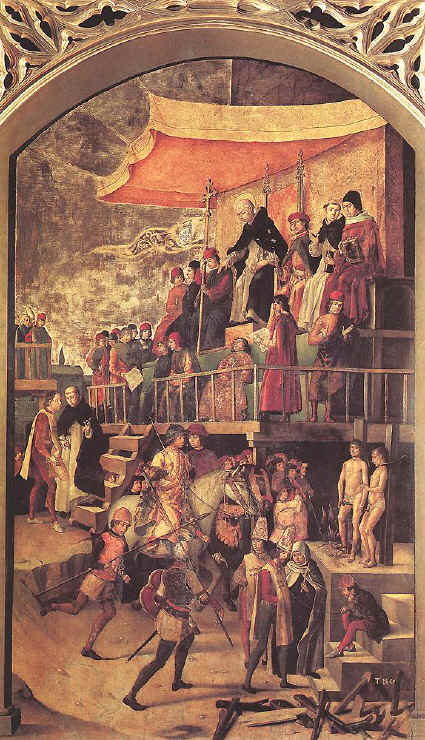
- In 1022, French king, Robert the Pious (996-1031) issued the first sentence of burning at the
stake for heresy. (The Latin label for this burning is auto-da-fe´: "act-of-faith".)
- In 1208 Pope Innocent II dispatched a papal legate, a Cistercian, Peter de Castelnau, to
demand that the protector of the Albigensians, Raymond VI of Toulouse, that they be destroyed.
Raymond refused and the Pope's legate was murdered, probably by an aid of Raymond of Toulouse.
- So, in the same year, the Pope declared a Crusade against the Albigenses, just as previous
popes had declared crusades against Islamic "infidels", acting under penalities authorized
by canon law.
- In 1223, the Dominican friar, Bernardo Gui (x-y) wrote Practica inquisitionis, aimed
at Jews who converted to Catholicism, then relapsed. (Semanticist Umberto Eco makes Gui the
inquisitor in his novel, The Name of the Rose, filmed in 1986, with Gui played by F.
Murray Abraham.)
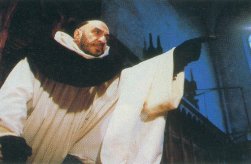
- In 1227, priest Conrad of Magdeburg claimed discovery of "underground Satanism", involving
worship of a huge black cat, inciting mob lynchings of suspects, but accusation of a powerful
nobleman lost Conrad his Papal license and Conrad was murdered.

- After the bloody extermination of The Albigensians, Pope Gregory IX, in 1223, announced a
system of legal investigation in Albigensian centers and (perhaps because of Gui's actions) put
it into the hands of the Dominicans.
- In 1235, Pope Gregory IX produced documents which formalized a legal system of investigation,
besides canon law, beginning The Medieval Inquisition.
- In 1252, the Encyclical Bull, Ad exterpanda, granted inquisitors the right to
torture.

- In 1307, Phillip IV of France, finding himself deeply indebted by loans from The Knights
Templar ("one of the great banks of The Middle Ages"), claimed evidence from the local Inquisitor
that The Templars were corrupt, infested by Satanism, and had ritualized homosexuality. Philip's
loans were cancelled, and Templar property was transferred to The Knights Hospitaller. 150
Knights Templar, including their Grand Master, were burned alive. Their order was disolved by
the council of Vienne in 1311.
- During his reign, 1316-1328, Pope John XXII put to torture and to death multitudes of
anti-papal Fratricelli ("Spiritual Franciscans"), Dolcinites, Wwldenses, Jews, lepers, alleged
witches, while amassing 25-million gold florins in specie, plate, and jewels, worth fifty million
then, perhaps two hundred million dollars today. Two thousand of the Fratricelli were burned at
the stake.
- The "Black Death", most endemic in the period 1348 to 1351, was often blamed on Jews, tortued
and put to death by the thousands, while hundreds of thousands were stripped of their property.
(Medical historians creedit widespread supersticious killing of cats with great increase of rats
whose fleas carried the plague germs. In some regions of Europe, 50% of population died,
eliminating whole crafts in many regions. To compensate, the Church allowed translation of "pagan
literature" to train craftsmen, which "opened the door" to "The Revival of Learning".)
- In Europe and Britain, the peasants served under a villeinage, i.e, conditions
under which a villein held landed tenure, a Medieval "share-cropper". (The word "villain" is
derived from this, a Medieval "Archy Bunkerish" slur of landlords.) The decrease of working
population due to The Plague caused a shift from villaineage to a more wage-base economy,
"putting the squeeze" on the peasants. In Germany, this led to "The Peasants Revolt" of 1381,
resulting in hanging and disembowelling of thousands of peasants, executionss approved my Martin
Luther (1483-1546), to maintain his support by the German Princes.
- The effect in Britain was to "send the ruling classes back to the altars of Rome" and the end
John Wycliffe's hopes of reform, thus delaying The Reformation in Britain for 150 years. For the
new Archbishop of Canterbury, William Courtenay (1342-96), accused Wycliffe of supporting this revolt
and contemplating similar disruptions in Britain. Acting on authority of Pope Urban VI
(1318-1389), Archbishop Courtenay invoked the Blackfriars Synod on May 17, 1382. Just as
proceedings began, a great earthquake struck London. Wycliffe interpreted it as God's warning to
what he called "The Earthquake Synod". But the Synod accepted Courtenay's interpretation of God's
judgment against Wycliffe and declared that Wycliffe's doctrines and writings were forbidden in
all English dioceses. But Wycliffe axhorted his preachers, "Why do you talk about seeking the
crown of martyrdom afar? Preach the gospel of Christ to haughty prelates, and martyrdom will not
fail you. What! I should live and be silent? Never! Let the blow fall, I await its coming."
Wycliffe was expelled from Oxford University. He had been translating The Bible into
English since 1374 and now had time to attempt completion. The "Whole Bible" was almost completed
by him before his death, the final work being done by his friend Nicholas of Hereford in 1388.
Wycliffe, "The Morning Star of the Reformation", received his fatal stroke while administering
Communion in his Lutterwork Parish Church on Dec. 29, 1384, dying Dec. 31. On 9th December 1427
the Pope ordered that John Wycliffe’s body be dug up and cast out of consecrated ground. His body
was exhumed from the grave in Lutterworth graveyard, burned, and the ashes thrown into the River
Swift that ran nearby.
 (The inspirational life of John Wycliffe has motivated such societies as the Wycliffe Bible
Translators (UK) and Wycliffe Bible Translators (USA), from which thousands of
missionaries have gone out, at risk and even life-sacrificing, to bring The Bible to
various peoples in their own language.)
(The inspirational life of John Wycliffe has motivated such societies as the Wycliffe Bible
Translators (UK) and Wycliffe Bible Translators (USA), from which thousands of
missionaries have gone out, at risk and even life-sacrificing, to bring The Bible to
various peoples in their own language.)
- In 1398, going beyond Gui's enquiry as to heresy or mere delusion, the Faculty of
Theology of the University of Paris determined that sorcery, satanism, even
cannablism, were heretical in compacting with the devil as lord.
- A procedure evolved for inquisition of alleged sorcerers:
- the nature and number of spells, divinations, invocatins known and used, and who instructed
this person in them
- knowledge of lost or damned souls
- nature of substances swallowed (such as hair and nail pairings) of the victim to gain control
- prediction of events
- information about fairies abroad at night -- good luck or not>
- A procedure evolved for inquisition of alleged witches:
- How long have you been a witch?
- Why did you become a witch?
- How did you becomes witch? what happened on that occasion?
- How is the one you chose as your Incubus? By what name do you summon him?
- What is the name of your master demon?
- What is the oath you rendered to him?
- What animals have you bewitched to sickness or to death?
- Who are your accomplices in evil?
- What is in the ointment you rub on your broomstick?
- What tempests have yuu raised, who helped you do so?
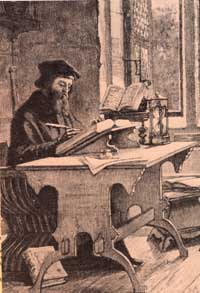
- 1377, trial of John Wycliffe (1328-1384), whose translations of The Bible into English have led some scholars to label him
"the father of English prose".

- In 1399, Plantagenet King Henry II of England was dethroned and perhaps murdered by
Lancastrian Henry IV, allegedly with assistance by Thomas Arundel (1353-?), Archbishop of
Canterbury (www.umiltas.com/arundel.html), on Henry's promise to persecute the Lollard followers
of .
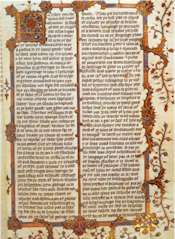
- In 1401, the English Parliament passed the first English statute for burning "heretics", a
statute which remained on the books until 1677. To ban Wycliffe's Bible, a 1413 statute declared,
"whoever read the scriptures in the mother tonge shall condemned as traitors and heretics, and
shall have forfeit land, cattle,body, life, and goods from his heirs forever". Archbishop Arundel had the
declared, "This pestilential and most wretched John Wycliffe of damnable memory, a child of the
old devil, and himself a child or pupil of Antichrist ... crowned his wickedness by translating
the Scriptures into the mother tongue." Multitudes of English, Irish, Welsh, Scot sympathizers
were driven into European exile. Wycliffe's Lollard followers were tortured and killed. "There
was no more wayside preaching, but instead ... secret conventicles in houses, in peasants' huts,
in sawpits, and in field ditches, where the Bible was read ..., and so Lollardy continued."
- Jan Hus (1369-1415) was a Bohemian reformer inspired by the doctrines of Wycliffe, with a
following known as "Hussites". For this, Hus was condemned by the Concil of Constance and
excommunicated in 1411. Hus was burned at the stake in Contsance on Jully 6, 1415, his ashes
thrown into the neaary Rhine River. Today a statue of Jan Hus is to be seen in the Prague old
town square.

- English lords, defeated at Orleans, Franch by Joan d'Arc (1412-1431), used the French office
of The Inquisition to try, condemn for heresy, and burn Joan at the stake in 1431.
- In 1480, establishment of The Spanish Inquisition, which allegedly brought wealth to King
Ferdinand of Spain (1452-1516) and Pope Sixtus IV (1414-1484), who recognized its independence.
- In 1483, Tomáas de Torquemada (1420-1498) was appointed Grand Inquisitor. Juan
Antonio Llorenta (1756-1823), official historian of The Spanish Inquisition, estimated that, in
total, 30,000 were burned alive, with 300,000 receiving lesser punishment.
- In 1488, an army of 18,000 Catholics attaked Waldenses in the Piedmont region of France,
setting fires at the mouths of their refuge caves, suffocating 400 infants, driving adults to
die by jumping down precipices, a total loss of 3,000 Waldenses. This event inspired the famous
sonnet of English poet, John Milton (1608-1574).
- In 1492, 500,000 Jews were expelled from Spain, their wealth confiscated. (Seventy years
later, Spain's population was reduced from 10,000,000 to 6,000,000 by banishment of Jews and
Moors.)
- In 1542, alarmed at spread of Protestantism, Pope Paul IV (1476-1559) established in Rome the
Congregation of the Inquisition, initiating "The Roman Inquisition or Holy Office". The
seminal event climaxilng this may have been the flight to join John Calvin in Zürich,
Switzerland, of Bernardino Ochino (1487-1564), who had been vicar-general of the
Observatine Friars and then vicar-general of the newly founded Capuchins. But Ochino was friends
of many suspected of heresy, such as the noble lady and friend of artist and sculptor
Michelangelo (1475-1564), Vittoria Colonna (1490-1547), and the Spanish converso, Juan de
Valdes (1500-1540), friend of Marguerite d'Angoulême (1492-1549), Queen of Navarre, as
well as sister of King Francis I (1494-1547) of France, and intermediary between Roman Catholics
and Protestants (2ages.htm ).
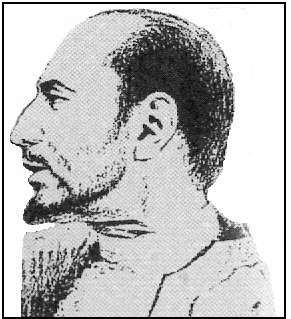
- In 1559, Pope Paul IV also established The Index of Forbidden Books. (One of these
was the anonymous classic which initiated the "picaro genre", Lazarillo de Tormes, cf.



 (The inspirational life of John Wycliffe has motivated such societies as the Wycliffe Bible
Translators (UK) and Wycliffe Bible Translators (USA), from which thousands of
missionaries have gone out, at risk and even life-sacrificing, to bring The Bible to
various peoples in their own language.)
(The inspirational life of John Wycliffe has motivated such societies as the Wycliffe Bible
Translators (UK) and Wycliffe Bible Translators (USA), from which thousands of
missionaries have gone out, at risk and even life-sacrificing, to bring The Bible to
various peoples in their own language.)





